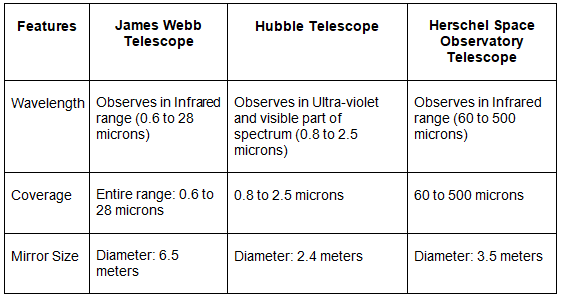UPSC Mains Previous Year Questions 2022: GS3 Science & Technology | Science & Technology for UPSC CSE PDF Download
Q1: Launched on 25th December, 2021, James Webb Space Telescope has been much in the news since then. What are its unique features which make it superior to its predecessor Space Telescopes? What are the key goals of this mission? What potential benefits does it hold for the human race?(Science and Technology)
Ans: The James Webb Space Telescope (JWST or Webb) is a large infrared telescope featuring a 6.5-meter primary mirror. Launched successfully from French Guiana on December 25, 2021, it is a collaborative effort between NASA, the European Space Agency (ESA), and the Canadian Space Agency.
Notable Features of James Webb Telescope compared to other Telescopes:
The James Webb and Herschel Telescopes orbit the L2 region, providing improved image capturing due to different wavelengths. The larger mirror size of the James Webb telescope facilitates the collection of a more extensive area compared to other telescopes. It is anticipated to surpass the capabilities of the Hubble Telescope, revealing stars and galaxies dating back 13.7 billion years.
Key Goals of James Webb Telescope:
- Search for the first galaxies formed after the Big Bang.
- Determine the evolution of galaxies from their early formation to the present.
- Observe the formation of stars from initial stages to the creation of planetary systems.
- Measure the physical and chemical properties of planetary systems and explore the potential for life.
Potential Benefits for Humanity:
- Understanding the formation and growth of early galaxies.
- Detecting potential signs of life on other planets, such as water and methane in exoplanet atmospheres.
- Observing the birth of stars, as infrared light can penetrate through dust.
- Studying black holes from different angles, providing valuable data on their temperatures, speed, and chemical composition.
- Observing the atmospheres of extrasolar planets beyond our solar system.
The James Webb telescope, succeeding the Hubble Telescope, is expected to contribute significantly to the understanding of ancient galaxies' mass, age, history, and composition, spanning various fields of astronomy and cosmology.
Q2: What is the basic principle behind vaccine development? How do vaccines work? What approaches were adopted by the Indian vaccine manufacturers to produce COVID-19 vaccines?(Science and Technology)
Ans: A vaccine is a biological product designed to safely stimulate an immune response, providing protection against infection and disease upon subsequent exposure to a pathogen. Typically, vaccines contain one or more protein antigens crucial for inducing immune responses that confer protection.
Basic Principle Behind Vaccine Development:
- Mimicking Natural Interaction: The fundamental aim is to induce protection against a pathogen by replicating its natural interaction with the human immune system.
- Immunological Memory: Vaccines prompt the immune system to create immunological memory through T and B lymphocytes, ensuring a rapid and effective response upon exposure to the targeted pathogen.
Working of the Immune System:
- Pathogen Response: When a pathogen infects the body, the immune system is activated to attack and eliminate the invader.
- Antigen Recognition: The part of the pathogen triggering antibody formation is called an antigen.
Working of Vaccines:
- Antigen Presence: Vaccines include weakened or inactive parts of an antigen, initiating an immune response in the body.
- Immune System Response: This weakened antigen version prompts the immune system to react similarly to its initial response to the actual pathogen.
India’s First Indigenous COVID-19 Vaccines:
- COVAXIN: Developed by Bharat-Biotech, it is an inactivated vaccine using Whole-Virion Inactivated Vero Cell derived platform technology.
- COVISHIELD: Developed by the University of Oxford with AstraZeneca, manufactured by the Serum Institute of India. It is based on a weakened version of the adenovirus found in chimpanzees, containing genetic material from the SARS-CoV-2 spike protein.
India’s Vaccination Milestone:
In a historic achievement, India's vaccination drive surpassed the 200-Crore milestone in July 2022. The country has consistently supported COVID-19 vaccine research, development, and manufacturing under the "Make-in-India" and "Make-for-World" strategy, leveraging cutting-edge technologies like CoWIN.
|
90 videos|490 docs|209 tests
|
















